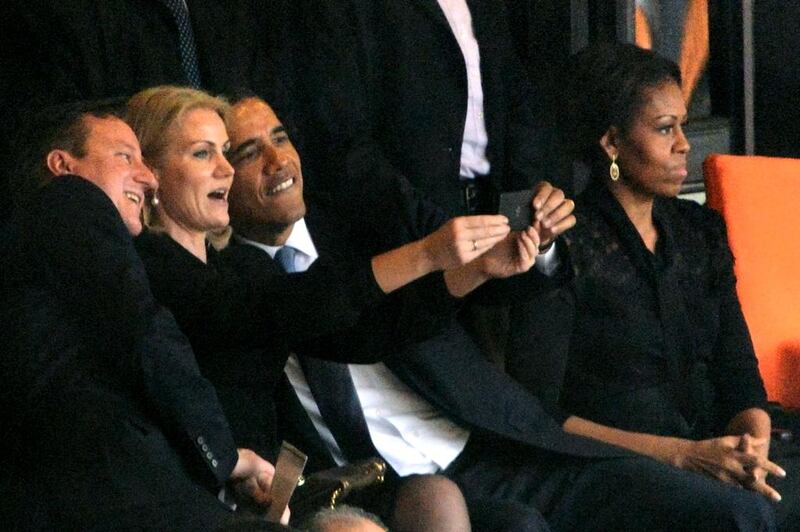The Oxford English Dictionary defines the term selfie as “a photograph that one has taken of oneself, typically one taken with a smartphone or webcam and shared through social media”. The craze has certainly been making waves over the past couple of years, and in recognition of its acceptance into our everyday vocabulary, the word selfie beat the luminaries Bitcoin and twerk to be named as the Oxford Dictionaries Word of the Year 2013.
Millions of selfies are taken week in, week out by people from almost all walks of life – everyone from the rich and famous to the young and old. Celebrities, athletes and presidents have all participated in the remarkable rise of this phenomenon. Sheikh Hamdan bin Mohammed, the Crown Prince of Dubai, even took a selfie while perched on top of Burj Khalifa.
The Middle East, in particular, is home to a large population of active social media users. Facebook is the leading medium in the region, followed by Twitter and Instagram, and all three play host to the relentless sharing of selfies. And to facilitate this further still, you can now treat yourself to a so-called selfie stick, an extendable rod for your smartphone that enables you to capture more detail from a much wider angle. The trend even inspired a hit dance song – titled #Selfie, of course – that was a staple of the world's radio stations and nightclubs not too long ago. But what about the technology behind the craze?
Smartphone makers have been providing front-facing cameras for some time now, but the seemingly insatiable appetite for the trend has sparked the coining of a new product segment – the selfie phone. The new selfie-inspired devices being developed typically, but not necessarily, fall into the midrange price category, and that is no coincidence. IDC data shows that the greatest gains for all smartphones in the region have been in the segments housing devices priced US$200 and below, so the positioning of selfie phones in this category is a strategically calculated move by the vendor community.
But what exactly is a selfie phone? Well, first of all it is important to consider it more as a marketing term than a true product segment in its own right. Essentially, it means a phone that comes equipped with both hardware and software enhancements aimed at helping the user to take better selfies. In terms of hardware, the front-facing cameras usually shoot photos of 5 megapixels or higher and employ a wide-angled lens that allows users to capture more detail in their photos.
Fitting perfectly into this generalisation is the Sony Xperia C3, which is described as featuring a PROselfie cam. The device comes with a wide-angle, front-facing 5-megapixel camera that is paired with a front-facing flash, while selfies can be taken simply by tapping the back of the phone.
IDC research shows Microsoft making slow but steady progress in the Middle East and Africa region with its Windows Phone operating system, but the company still has a long way to go in its battle with Android and iOS. And it appears the selfie phone segment will host the next round of that particular bout, with Nokia throwing its Windows-equipped Lumia 730 and 735 devices into the ring. Both phones feature a 5-megapixel front-facing camera and come equipped with the Lumia Selfie app.
Breaking the mould are Huawei and Lenovo, which are weighing in with 8-megapixel front-facing cameras on their respective Ascend P7 and Vibe Z2 devices. Huawei even went a step further by trademarking the phrase “groufie“, as the panoramic option on the Ascend P7’s front-facing camera gives users the option to take better-quality group selfies.
HTC has even tried to get a piece of the action with its One M8 flagship device, with the front of the phone sporting a 5-megapixel shooter, while the reverse side houses only a 4-megapixel version. The phones discussed here are not the only ones available with such features, but they do offer a worthwhile glimpse into the market’s future direction, with rumours growing by the day of an imminent selfie-phone release from the market leader, Samsung.
The emergence of the selfie phone is not just a matter of hardware, as these devices are all ably supported and supplemented by dedicated software apps. In some cases, these are already included on the phone, and in others they are downloaded at a later date from the various smartphone app stores. These software apps allow users to retouch, edit and add effects to their photos, and there are even options to install smile detectors and timers.
As the selfie phenomenon continues to grow both globally and locally, smartphone makers have shown that they are keen to not only be part of the experience, but also enhance it. And as megapixel upgrades for rear-facing smartphone cameras continue to slow, IDC firmly believes that users can expect more progress to be made on the front.
But wait, before you go, let me take a selfie.
Saad Elkhadem is a research analyst at IDC MEA
Follow The National's Business section on Twitter





